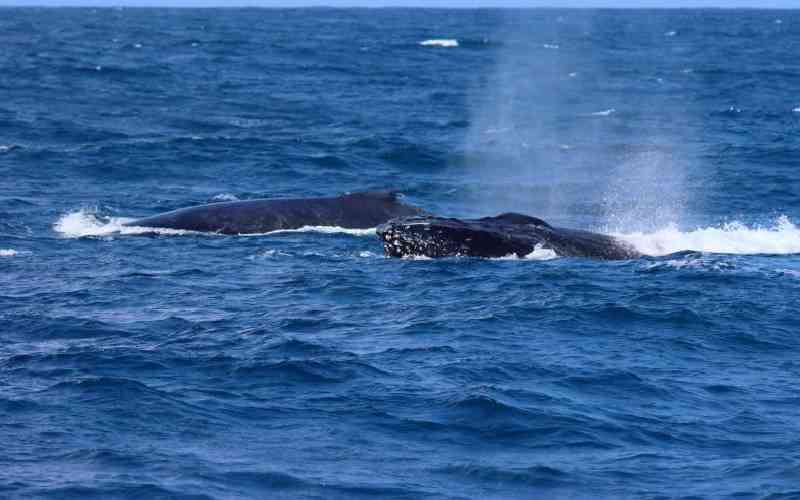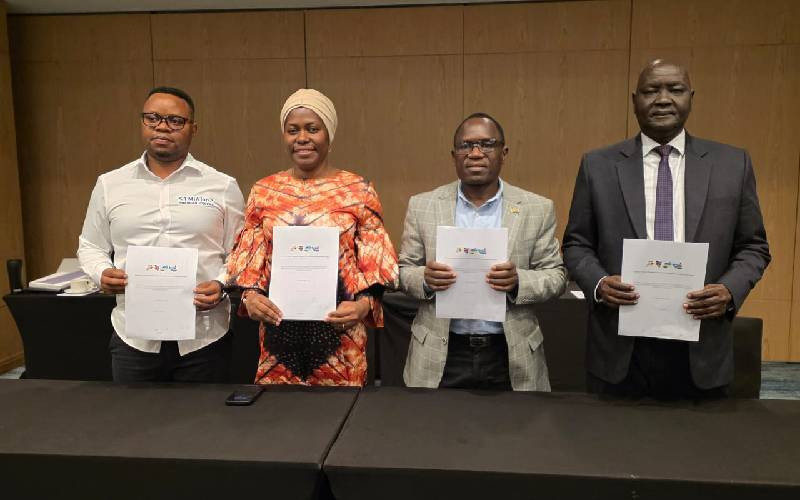
At 7am, Ali Hamisi Mwaluma is already at his post on the highest point of Watamu Beach, a spot that has served as his office since 2017.
From here, the ocean stretches endlessly before him, with binoculars hanging from his neck and a clipboard tucked under his arm, Ali settles in to watch.
Alongside his colleagues, he sets up on a vantage point facing the sea, his eyes scanning the horizon for any sign of the migrating humpback whales. Every wave, every splash, every shadow on the water demands attention, and when a shape seems suspiciously larger than the ordinary surf, he quickly jots down notes on the data sheet.
“Every day from July to September, when the whales are migrating, I come here with my data assistants to see if we can spot any. There are years when the numbers are many—but this season, we have recorded only two sightings,” he said.
What Ali and his team conduct is a land-based survey, one of the most effective and accessible methods in marine mammal conservation.
From fixed coastal points, observers like Ali record whale sightings, behaviours, and migration timing—crucial data that forms the backbone of marine research around the world. In Kenya, land-based surveys have been one of the few consistent sources of whale data since around 2014.
“What we usually observe are the whales breaching, blowing, or slapping their tails on the water. With dolphins, it is different because we see their acrobatics. I have very sharp eyesight, and when I spot a whale, I can tell immediately. I alert my team, we confirm the sighting together, and then we make contact with the office to record it,” he said.
But the challenges are stark. Their tools are basic—binoculars and data papers—and their work is limited to just the cooler morning hours before the sun becomes unbearable. Lacking boats or night-vision equipment, surveys cannot extend offshore or into the evening.
“Sometimes the sea plays tricks… you stare so long that you think every swell is a whale. Lacking acoustic devices or drones, many sightings remain unconfirmed, making data uncertain and incomplete,” he said.
This scarcity of data stands in stark contrast to South Africa, where land-based surveys have been running for decades. According to research published in Marine Mammal Science in 2015, long-term monitoring from Cape Vidal in the iSimangaliso Marine Protected Area recorded more than 14,000 humpback whales migrating past the KwaZulu-Natal coast each season, with the population showing an average annual growth rate of 7.1 per cent to 7.4 per cent between 2011 and 2015.
These findings were made possible through systematic, shore-based surveys that have allowed scientists to track recovery trends of Southern Hemisphere humpback populations with precision. In Kenya, by comparison, no such surveys exist, and the true number of whales migrating along the country’s coastline is unknown.
Kenya’s 600-kilometre coastline—from Kiunga to Vanga—is home not only to humpbacks but also blue whales, Bryde’s whales, sperm whales, Longman’s beaked whales, and pygmy sperm whales—all documented by researchers and citizen scientists. Yet comprehensive population assessments or migration mapping are undeveloped.
Data from the Kenya Marine Mammal Research and Conservation (KMMREC), with support from the International Fund for Animal Welfare (IFAW), shows that strandings of whales and dolphins along Kenya’s coast are rising. From 2004 to 2019, only 25 strandings were recorded—less than two a year on average. But the numbers have gone up sharply in recent years, with 12 cases in 2020, 18 in 2021, and 17 by mid-2024. These strandings have given scientists a chance to study dead animals through post-mortems, uncovering rare species like pygmy sperm whales that are almost never seen at sea. Still, because Kenya lacks long-term monitoring, the reasons behind the strandings remain unknown, and conservation teams can only act after the animals wash ashore.
Globally, the stakes could not be higher. Humpback whales are a conservation success story, with approximately 135,000 individuals worldwide and a growing population trend. Each whale sequesters roughly 33 tonnes of CO2 annually, vastly exceeding the 0.02 tonnes stored by a tree, exemplifying whales’ overdue recognition as vital climate allies.
Stay informed. Subscribe to our newsletter
Through the “whale pump,” they fertilize surface waters with nutrient-rich waste—especially iron and nitrogen—stimulating phytoplankton blooms that capture carbon and support the marine food web.
Whale conservation also brings regional climate leverage: half of Earth’s atmospheric oxygen comes from phytoplankton, made more productive by whales.
The IMF estimates that current global whale populations contribute over US\$1 trillion in climate regulation and ecosystem value, and each whale equals over US\$2 million in ecological benefit.
Humpback whales pass Kenya’s coast between July and September, arriving by late June and lingering until as late as October for breeding and resting. Numerous mothers with calves spend weeks in these waters—yet their visits remain under-documented.
Despite this rich marine heritage, experts warn that Kenya lacks critical data on these species—data that could determine whether they thrive or vanish in the coming decades.
According to the Wildlife Research and Training Institute (WRTI-Kenya), Head of the Coastal and Marine Research Centre, Senior Principal Dr. Mohammed Omar, the lack of advanced technology is one of the biggest barriers to understanding the country’s marine ecosystems.
“Our ocean is still a mystery. Beyond 30 metres of depth, we have almost no data, yet our Exclusive Economic Zone stretches thousands of nautical miles into the Indian Ocean. Right now, we only know about the shallow reefs close to shore, but the deeper waters—which make up the largest part of our marine territory—remain unexplored. This is why we want to use modern technology like deep-sea cameras, underwater drones, and acoustic sensors to collect information where divers cannot reach. The truth is simple: we cannot protect what we do not understand. Expanding research into these deeper areas will take significant resources, but it is the only way to secure the future of our marine ecosystems and support Kenya’s blue economy,” he said.
He added that these data gaps also affect the livelihoods of coastal communities that depend heavily on tourism and fishing. Inadequate research undermines both sectors, threatening jobs and the local economy. Dr. Omar notes that collaboration with stakeholders—including local fishers, conservation groups, and international research partners—offers a way forward.
“When people do not see real benefits from conservation, it is natural for them to lose interest. The issue is not that they don’t care—it is that we have given them structures without the training and tools they need. Our focus now is on true empowerment through practical skills like financial management, governance, and sustainable business development,” he said.
IFAW board member Judi Wakhungu adds that Kenya cannot close the data gap on whale conservation alone and that partnerships with countries that have advanced marine technology and expertise are critical because through such collaborations Kenya can gain access to modern research tools, share knowledge and jointly map marine habitats and migration routes that stretch far beyond its territorial waters, making cooperation the surest way to build the solid scientific foundation needed for long-term conservation policies.
“Protecting whales is not just a Kenyan responsibility but a global one because a whale’s journey cuts across many borders, reminding us that conservation is a shared duty and our role is to create strong partnerships that ensure these giants of the ocean are not only studied but safeguarded for future generations,” she said.






